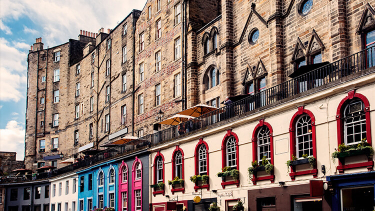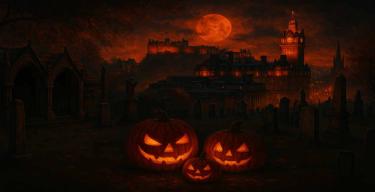A large part of Scottish historical heritage resides in this city located northwest of Edinburgh. With our Stirling Travel Guide we will try to summarise all the information needed before you visit.
The hill it occupies and the River Forth aided its defense against the Romans first and the English and Jacobites afterwards. It was the only place where the river could be crossed without the need for a ferry. Being such a strategic position, it was also called the “Gate of the Highlands”. It was even said of this city that whoever defended it would support all of Scotland.
According to an ancient legend from the 9th century, when the city was temporarily under Anglo-Saxon rule, it was attacked by Viking invaders. The sentry slept peacefully until he was awakened by the providential howling of a wolf. Seeing that danger over the garrison, he warned the enemies they fled. From that moment the city would adopt the wolf as a symbol.
If you want to relive those moments for history and move for a few moments to the Middle Ages, you are in front of your ideal city. You can stroll through its busy streets flanked by stone buildings, climb the imposing castle or collect yourself in the tranquility of the Church of Holy Rude. As you can see, depending on what your interests are, the possibilities are very wide.
What to see in Stirling?
Stirling is not too big a city, it barely has a little more than 30,000 inhabitants, so you can easily get around on foot in just one day. In any case, since we don’t want you to miss out on anything it has to offer, we have selected these places especially for you.
Historical center of the city

Broad Street y la Mercat Cross
For some historians, the origin of the city is intimately linked to the medieval markets. In this case, Stirling was born in the heat of a castle that protected it, but also from a very active market.
In this sloping square that today crosses Broad Street, there is the column of a national symbol of Scotland: the unicorn. These columns, which did not necessarily have to raise a unicorn at its peak, designated the city as a point where it is allowed to trade.
Right at the end of the street you will find the Mar place and the Mar’s Wark, an old palace. If you continue that way you will reach the esplanade of Stirling Castle.
Saint John Street
The street dedicated to Sainth John is one of the most important in the city. It runs parallel to Broad Street and has the important tourist information center (just behind is the old Stirling prison), the magnificent Holy Rude church and again the Mar place.
When to visit these streets?
You should visit them when the establishments are open. Otherwise, you will have to visit it if you want to visit the main monuments of this city.
How to get?
Stirling has grown right at the foot of the hill where the castle is located, therefore these historical streets are precisely those that run down the hill. Of course, the growth of the city was in a south-southeast direction. So, if you come from Edinburgh, you will have to cross a good part of the New Town, always in the direction of the castle. You will find them without any problem.
Stirling Castle

It is one of the largest and most important fortresses in the entire UK. The castle is located on a rock that was once a volcano. It has not been active for a long time. Its appearance is impressive, especially due to the steep cliffs that surround it. It can only be accessed through the town by a not too steep slope.
Like Edinburgh Castle, Stirling Castle also welcomes you with a wide esplanade. There awaits you the monuments dedicated to two of Scotland’s most commemorated and recognized heroes: King Robert the Bruce and William Wallace. The entrance to the castle grounds has an addition from the 18th century, but the oldest remains date from the 12th century.
During those centuries, the Stirling Castle was witness of multiple battles. It became a royal residence from 1216 and a Jacobite defense in 1746. From its walls you will have several awe-inspiring views.
Inside you will find the Renaissance Palace of Jacobo V, whose Great Hall is considered one of the greatest attractions of this castle. Its yellow facade is unmistakable and is full of magnificient Renaissance furniture. Without realizing it you will find yourself walking among the memories of the old Scottish monarchy. But if military history is your thing, you also have the Highlanders Regiment Museum. It was an elite unit that came to fight in the Crimean War and in the famous Battle of Normandy of World War II.
When to visit this Stirling castle?
Between April and September it is open from 9:30 a.m. to 6:00 p.m. In winter, including the months between October and March, it opens from 9:30 a.m. to 5:00 p.m. Be careful because the last ticket is sold 45 minutes before closing. December 25 is closed.
How to get?
You will see it at the top of the hill from anywhere in the city. To get there you will have to climb the streets of the Old Town. In fact, to reach it, you must leave behind the Church of Holy Rude and the cemetery. A little further on, the esplanade and the monumental entrance will wait for you.
Ticket price
Adults will receive £ 14 for a single entry, while children (5-15 years) will pay only £ 8.40. There is a discount for the unemployed and retired, reducing the rate to £ 11.20. Ah! Very important, children under 5 and those with the Explorer Pass will be able to access for free.
Holy Rude Church.

At the end of Saint John Street, at the foot of the castle, you have the Church of Holy Rude (or the Holy Cross). The temple that you can visit today was built in the 15th century, but one had already existed there at least since the 12th century. This was so because, like many buildings of that time, it would suffer a fire that would force its reconstruction.
It is a relatively small Gothic temple. Outside you can see a façade reinforced with staggered buttresses, characteristic of Scottish Gothic. The interior stands out for the wide stone walls, the pointed arches on round pillars, the large windows and the oak roof that dates back to the Middle Ages. In this church the founder of the Presbyterian Church, John Knox, would preach, Mary Stuart would pray and his son, James VI of Scotland would be crowned in 1567.
On the green slopes surrounding the building is the cemetery of the same name. It is worth strolling among its ancient tombs. Both the gardens and the tombstones are very well kept. As you can see, an exceptional place for lovers of Scottish architecture and history.
When to visit this church?
Between May and September it is open every day of the week from 11:00 to 16:00.
How to get to the Holy Rude church?
To reach the Church of Holy Rude we recommend that you go in the direction of the castle. In any case you will find it in the street of Saint John, right next to the palace of Mar’s Wark.
Ticket price
You’re lucky! Access is completely free.
Two homes of the nobility: Argyll’s Lodging and Mar’s Wark

Argyll’s Lodging is a 17th century manor house in the Renaissance style. It was a residence of the Earl of Stirling and later of the Earls of Argyll. During the Napoleonic Wars it would also be a military hospital. The Royal Commission considered it as one of the most important houses of its time. That it has survived to this day and that you can visit it practically without modifications is a real fortune.
The Mar’s Wark is a building that is in ruins, only the facade has survived. It was built in the 16th century by John Erskine, Regent of Scotland and Earl of Mar. Some historians have said that it was never completed, but the truth is that there is little evidence to confirm it. It is known that the Countess Annabella used it as accommodation and that it would be used as a barracks and to mount artillery during the Jacobite uprising of 1715.
When to visit these palaces?
You can only visit the Argyll’s Lodging under strict visiting hours. You can check the details here.
Since de la Mar’s Wark only survives the façade you can contemplate it whenever you want. It is a notable example of Renaissance architecture at street level. On your way to the castle you will be immediately struck.
How to get?
Both palaces are very close to the Church of Holy Rude, in the so-called Plaza de Mar (Mar Place). If you follow the path that leads to the castle, you will find Mar’s Wark first and then, on the right bank, Argyll’s Lodging.
Ticket price
You can access Argyll’s Lodging with the same entrance that you will use for the castle. Of course, try to review the schedules to be able to combine both visits at the appropriate interval. As you know, you can only see the façade of the Mar’s Wark, not the interior.
William Wallace National Monument

On a hill north of Stirling stands the tower dedicated to Scotland’s national hero, William Wallace. This 13th century soldier would fight against King Edward I of England in the War of Independence. If you have enjoyed with Braveheart do not hesitate to come and explorer the place. Inside you will find a replica of this warrior’s sword!
The tower was completed in 1869 thanks to a fundraising campaign. Among the donors was the famous Italian leader Giuseppe Garibaldi. It is a 70 meter high Victorian Gothic style tower, based on sandstone and designed by the architect John Thomas Rochead. It is said that from the hill on which it is located was where William Wallace observed the English army in the battle of Stirling Bridge.
To access the monument you have to climb the hill. Once inside the building, arm yourself with patience to ascend the 246 steps that separate you from the highest point. From there you will have great views of the city of Stirling, the Ochil Hills and the valley through which the River Forth runs.
When to visit this tower?
From here, you can have a look to the William Wallace monument website.
OPENING TIMES
January & February: 10.00am – 4.00pm
March: 10.00am – 5.00pm
April to June: 9.30am – 5.00pm
July & August: 9.30am – 6.00pm
September & October: 9.30am – 5.00pm
November & December: 10.00am – 4.00pm
Last admission – 1 hour prior to closing
How to get?
On a good day you can walk from Stirling in just under half an hour. You should be heading towards the Stirling Bridge (Old Stirling Bridge) on a sidewalk road. You also have the option of taking city buses. They’ll drop you off in about ten minutes. We leave here the updated schedules so you can better organize yourself. The price of the bus is around £ 2.50.
Ticket price
If you have visited Stirling Castle before, they will give you a small discount if you present your ticket. This monument is not included in the Explorer Pass. For adults it costs £ 10.75, while students/seniors (aged 60+) and children pay £ 8.75 and £ 6.75 respectively.
Stirling bridge

Just minutes from Stirling Castle is one of Stirling’s most iconic sights, the Old Stirling Bridge. It is a stone bridge with more than five hundred years of history. It was built in the 15th century, but there had been other wooden bridges there before. In fact, one of those bridges was where the famous battle would take place where William Wallace defeated the English in 1297.
When to visit this bridge?
You can walk through it whenever you like. The bridge is pedestrian and offers wonderful views of the River Forth, the castle, and the William Wallace Tower.
How to get?
It is a twenty minute walk from Stirling Castle. You must follow north towards Orchard House Health Center Hospital. Once you pass it you will see the river, you just have to follow the opposite direction to its course to find it.
Curious facts about Stirling
- Stirling is the smallest city in all Scotland. She received that status in 2002 from the Queen Elizabeth II. It is also the place where the History and Art of the monuments of its historic center are in the culture and avant-garde of its prestigious University.
- Your perspective of Stirling Castle can vary quite a bit if we tell you that it dominates the battlefields where the Scottish War for Independence was fought. Even more so if Mary Queen of Scots, also called Mary Stuart, reigned in it.
- The Church of Holy Rude is the only one, apart from Westminster Abbey, which has celebrated a coronation.
- If you take a walk through the Old Town you will see that it preserves its characteristic medieval style. Largely thanks to the dedicated preservation of the buildings, as well as its Renaissance references, easily noticeable in the churches and period residences.
- Be aware that just behind the visitor center is the Victorian prison. Do not forget to take a look, as well the tower that is located just ahead. There are always events related to art and music.
- On top of thatt, you should know that Stirling is also famous for its ghost stories. One of the most famous is that of the Pink Lady, who says she has been sighted by several soldiers from the castle. The nearby Settle Inn motel has also been considered one of Scotland’s most famous ghost spots.
What’s the weather like in Stirling?
Rainfall is well known in Stirling city. Even in the driest months it tends to rain often. The approximate average precipitation is 1014 mm. Despite this, its average annual temperature is around 8.5 ºC. Between June and September the temperatures are between 15 and 19 degrees. We strongly recommend the raincoat as an part of your visit.

Data from Climate Data
How to travel to Stirling?
From Edinburgh you can reach the city of Stirling in about an hour by car. On the other hand, if you leave from Glasgow you can be in just over half an hour.
If you do not have the possibility to take a car, you can travel by train or bus. By train, several of the ScotRail company leave Edinburgh station and will leave you there in fifty minutes. The price is around 9 pounds. In addition, Stirling station is very close to the castle, so you can reach it in about ten minutes.
If you choose the bus as a means of transport, both the Citylink and the Megabus can be a good option. Prices range from £ 5 to £ 9. Like the train station, the bus station is very close to Stirling’s Old Town.
Where to stay in Stirling?
If you want to spend more than a day in Stirling, we can recommend various accommodation options, although we must bear in mind that this city is smaller. Therefore, you have some guest houses, hotels and hostels, and cozy Break & Breakfast. Here we leave you two economically interesting possibilities:
Stirling Youth Hostel
This hostel is in Stirling’s Old Town itself, next to the city’s old Victorian prison. The property is just a five-minute walk from Stirling Castle. Fifteen minutes from the train station and one minute from the nearest bus stop. From here you can also take a bus to the William Wallace Monument. All rooms have a private shower and toilet. Prices range from € 40 to € 100 per night depending on the season in which we decide to travel there.
Stirling Highland Hotel
This hotel was at the time the Institute of the city. It is less than a ten minute walk from Old Town and Stirling Castle. You also have free parking. The rooms are light and spacious. Inside is the Scholars restaurant, which serves traditional and international cuisine. Also, if you want to try any type of drink you have the Headmaster’s Study bar. The prices of this hotel are around € 100 per night approximately.
Information of interest
If you are interested in getting to know this city, you should know that it has a tourist information office, the Stirling VisitScotland iCentre. It is located in the Old Town of the city, a little before reaching the Church of Holy Rude. In addition to some booklets with information about the place, they can provide you with accommodation reservations, bus tickets, lake cruises, etc. Here we leave you the address and your means of contact:
Stirling VisitScotland iCentre
Old Town Jail, St John Street Street. Stirling FK8 1EA, UK
Telephone: +44 (1786) 475019
E-mail: [email protected]


















Previous comments...